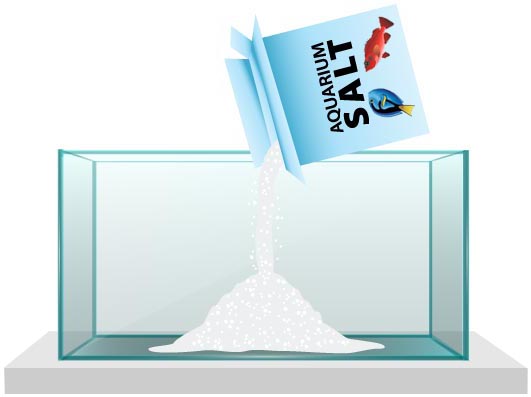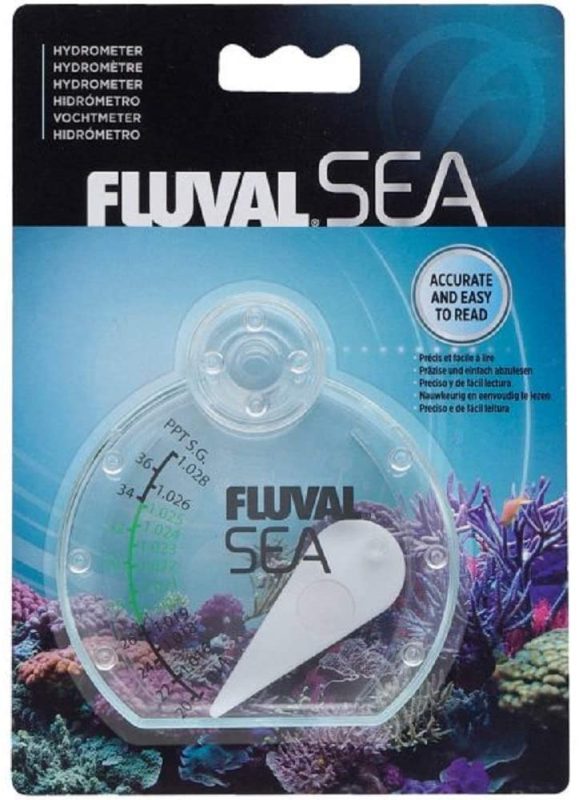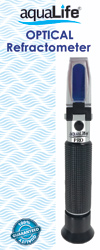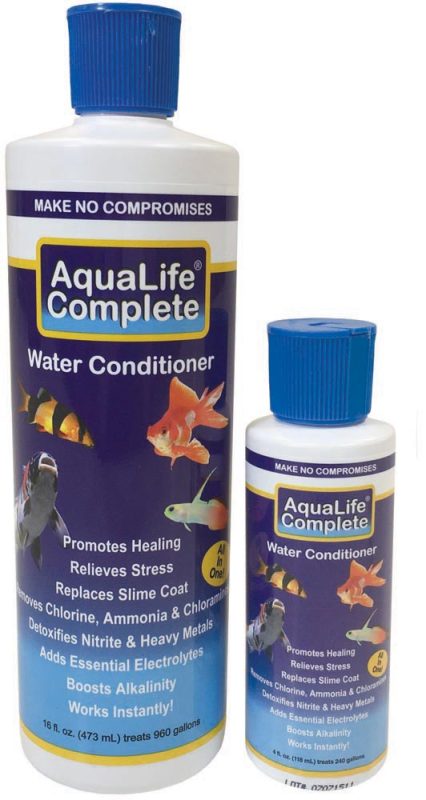7. Mixing Saltwater for the Aquarium

Mixing saltwater for the aquarium and adjusting salinity are critical to the saltwater aquarium environment. There will be two occasions where you add salt mix to the aquarium – your new aquarium before you add fish and other livestock, and your established aquarium during monthly maintenance. Following the steps outlined below will ensure accurate results for both.
Specific gravity, or relative density, is a measure of the salinity of the aquarium water after adding salt, and is a critical measurement when mixing saltwater for the aquarium. Aquarium salinity is generally set to mimic the average salinity of sea water, between 1.020-1.022 for FOWLR Fish only aquariums or 1.025 for reef aquariums, and is measured with a hydrometer or a refractometer. Purchase a good, reliable hydrometer to measure the salinity of your water. If you decide to use a hydrometer, your local dealer may be able to calibrate your hydrometer against a refractometer for the most accurate readings at home. Refractometers are also available for home aquaria and are a must for any serious hobbyist. The professional quality aquaLife Refractomer is the best available and will provide years of accurate service.




View All Hydrometers
View All Refractometers
View All Thermometers
Mixing in a new aquarium without livestock
A new system should be run with freshwater prior to adding salt. This test run allows time to check for leaks, locate equipment problems and avoid wasting salt.
After all system equipment is installed and running properly, decorations are in place, the tank has been filled with freshwater and dechlorinated, salt can be added slowly and mixed directly in the tank. When mixing saltwater for the aquarium, small amounts of salt are added at several intervals and allowed to mix thoroughly before checking salinity with a hydrometer.
Salinity can be checked while water is still cloudy, but there should be no undissolved salt at the bottom of the tank. Continue adding salt until the salinity measures 1.020 on the hydrometer. Once the proper salinity has been reached, allow the tank to totally clear and reach a constant temperature of 76-78°F. Allow 24 hours for settling and temperature compensation.
When the tank is clear and the temperature is correct, adjust the salinity to 1.022 (1.025 for reefs) by adding small amounts of salt. If the salinity measures above 1.022 or 1.025 for reefs at a temperature of 76-78°F small amounts of water will have to be removed from the tank and replaced with dechlorinated freshwater. When mixing saltwater for the aquarium, this may have to be repeated until the salinity is correct.
Once these goals are reached, it’s time to slowly add livestock or cycle fishes with Ammo! Purchase a few inexpensive fish in the beginning and acclimate them according to your store’s instructions. Closely monitor the ammonia level after adding the fish. You should expect that the ammonia will read on your test kit, but within a few days, you should see the level drop to zero as your filter system begins to neutralize the ammonia. Overfeeding is also a source of ammonia, so feed your fish sparingly during this period. This stage in the life of your aquarium is a good time to use aquaLife Activate Saltwater Aquarium Starter and Cleaner to help jump start your filter by seeding it with beneficial bacteria to help with eliminating ammonia. Seeded BioMatrix is available locally and is great when used with Activate. See the Cycling Solution for more details.
See All Test Kits
Water Changes with livestock
NEVER ADD SALT MIX DIRECTLY TO THE TANK!
Turn off the filtration equipment and remove 10-25% of the tank water by siphoning with a gravel cleaner. Keep track of the number of gallons of water removed by siphoning into measured buckets. Follow the procedure below to mix and replace the water removed from the tank during cleaning and siphoning.
1) Check the temperature of the water in the aquarium.
2) Add 5 gallons of water to a non-toxic container (one used only for the aquarium), at the same temperature as the aquarium.
3) Add RPM Reef Pro Mix Complete Sea Salt saltwater mixture to the container at approximately 2.5 cups per 5 gallons of water (about 1/2 cup per gallon of water.) Add dechlorinator and mix thoroughly. No crystals should be left undissolved. For larger aquariums use larger containers and take the proportions up. Water can also be purchased premixed and is available locally and professionally prepared with RO reverse osmosis water. We offer both RO fresh and saltwater in 2.5 and 5 gallon containers.
The longer ahead the water is made the better. The temperature must be the same as the aquarium water. As long as all the salt is dissolved it is safe for use in about 15 minutes. RPM Reef Pro Mix Complete Sea Saltis a high grade saltwater mix that contains all of the major elements found in sea water and it mixes quickly. Buffers are added that may give a slight cloudiness that will clear quickly. Aquavitro Salinity is another high quality salt mix and is sold only at our local store.
4) Once the new saltwater has been added to the tank, clean and restart all equipment. Always re-check the salinity.
Special Note!
As water evaporates from the aquarium, the salt concentration of the remaining water increases. Salt does not evaporate. Always add dechlorinated freshwater to top off the tank.
Synthetic Sea Salt and pH
RPM Reef Pro Mix Complete Sea Salt, 200 gallon box – This mix creates the perfect environment for delicate marine life, as well as supporting enhanced biological filtration. Extra calcium and magnesium to benefit corals and other invertebrates in reef tanks. RPM Sea Salt achieves the correct salinity, pH, calcium concentration and magnesium concentration when re-hydrated as directed. Aquavitro Salinity is sold only at local authorized dealers, like our local store.
• Do a 25% water change monthly or a 10% water change twice a month. Remember to dechlorinate the water and adjust it to the same temperature as the aquarium water.
• The pH should be 8.2. High quality salt such as RPM Sea Salt has added buffers and with proper water changes, pH should be stable. However, if pH becomes a problem with water changes in reef tanks, use Marine Buffer or Reef Builder by SeaChem. Further information is available on water parameters in the Log Sheet section.
• Always add a high quality dechlorinator anytime tap water is added to the tank. aquaLife Complete is an excellent product that not only dechlorinates but adds important elements to maintain slime coat integrity and reduce stress. aquaLife Complete also detoxifies chloramines if they are present.
• Chloramines
Municipal water treatment plants in some areas, in order to make water safe for human consumption, add chemicals to the water that can kill your fish. If chloramines are present in your tap or tank water, use aquaLife Complete.
A word about tap water . . .
Tap water is prepared for human consumption and is not safe for use in aquariums. Chlorine and fluoride are added to tap water for the protection of humans but will kill your fish and wipe out the beneficial bacteria in filters. Water conditioners are inexpensive and neutralize these toxic compounds. Good water conditioners bind metals and enhance the slime coat barrier of fish to help prevent disease. Reverse osmosis or ion exchange water significantly reduces excess algae growth in reef tanks and saltwater fish tanks. Reverse Osmosis units from Aquairum Life Support Systems are among the best money can buy. These units produce soft, phosphate-, silicate-, and nitrate-free water. When using reverse osmosis water, remember to use aquaLife Complete to replace essential elements back into the water. Pre-treated water can be purchased at better aquariums stores. For small water requirements this is often very convenient.

 29-75 Gallon Marine Fish (FOWLR) Tank Setup Guide Fish Only with Live Rock
29-75 Gallon Marine Fish (FOWLR) Tank Setup Guide Fish Only with Live Rock




